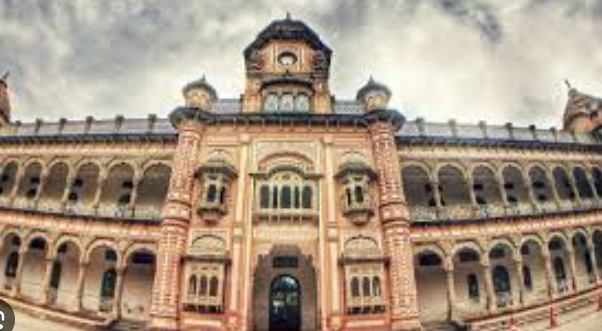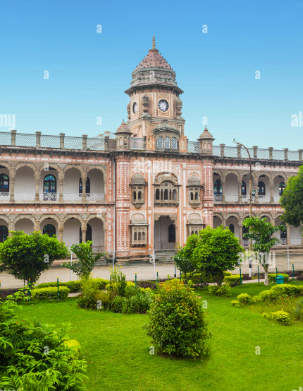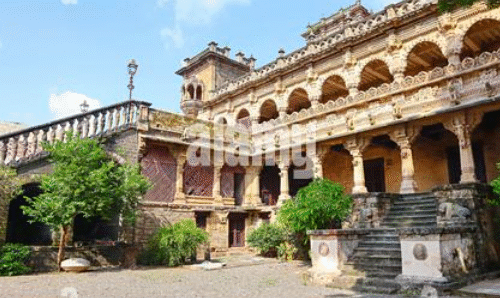Mubarak Mandi Palace History is a historic monument in Jammu. It was once the royal residence of the Dogra kings. The palace is famous for its beautiful design, rich history, and unique architecture.
Let’s explore the full story of this grand palace in a simple and easy-to-read blog.
Location of Mubarak Mandi Palace History
Mubarak Mandi Palace is in the heart of Jammu city, in the Union Territory of Jammu and Kashmir, India.
It stands on a hilltop, offering views of the Tawi River. The palace is located near the old city market, making it easy to reach by road.

History of Mubarak Mandi Palace History
A Royal Residence
The Mubarak Mandi Palace was the seat of power for the Dogra rulers of Jammu and Kashmir. The palace complex was used for official ceremonies and as a royal home. Mubarak Mandi Palace History
Built Over 150 Years
Construction started in the early 18th century and continued till the 20th century. Different rulers added new buildings and styles over time.
A Fire and Earthquake
In 1925, a major fire destroyed many parts of the palace. In 1980, an earthquake also damaged the structure. Since then, the palace has been in need of repair.
Design and Structure of the Palace Mubarak Mandi Palace History
A Large Complex
Mubarak Mandi is not just one building. It is a group of buildings spread over a large area. The palace complex includes:
- Darbar Hall (Royal Court)
- Rani Charak Mahal
- Gol Ghar Complex
- Pink Hall
- Royal Offices
- Sheesh Mahal (Mirror Palace)
Each section had its own purpose – for administration, meetings, or royal living.

Fort-like Design
Though called a palace, its outer walls are strong and thick like a fort. There are many gates and courtyards. This gave protection from outside attacks.
Architecture of Mubarak Mandi Palace
A Mix of Many Styles
The architecture of the palace is a blend of different styles. You can see elements of:
- Rajasthani architecture
- Mughal architecture
- European baroque style
This mix of styles gives the palace a very unique and rich look.
Arches, Jharokhas, and Courtyards
The palace has arched windows, jharokhas (balconies), and large courtyards. These are common in traditional Indian palaces.
The walls have carved patterns, and some rooms have mirror work and colored glass.
Local Materials
Builders used red sandstone, lime, and bricks. Wood was used in the doors, ceilings, and floors. The rooms stay cool in summer and warm in winter.
Important Parts of the Palace
Dogra Art Museum (Pink Hall)
One of the buildings, the Pink Hall, now houses the Dogra Art Museum. It displays royal items like:
- Paintings
- Weapons
- Costumes
- Manuscripts
- Ceramics
It gives a glimpse into the rich culture of the Dogra rulers.
Darbar Hall
This was the royal court where the king met ministers and guests. It is the grandest hall in the palace.
Sheesh Mahal
This is the mirror palace. The ceilings and walls are decorated with small pieces of glass. When light falls, it shines beautifully.
Current Condition and Restoration
Restoration in Progress
Today, parts of the palace are in bad shape. Time, weather, fire, and earthquakes have caused damage.
The Archaeological Survey of India (ASI) and local government are working to restore it.
Some areas are closed for public safety. Others are open to visitors.
Heritage Status
Mubarak Mandi is a state-protected monument. It is being developed as a heritage tourism site.
Why You Should Visit Mubarak Mandi
Scenic View
From the palace, you get a beautiful view of the Tawi River and the surrounding hills.
A Photographer’s Delight
The architecture and ruins provide great spots for photography.
A Place to Learn
It’s perfect for people who love history, art, and culture. The museum adds more value to the experience.
Travel Tips
Best Time to Visit
Visit during October to March when the weather is pleasant.
Timings
Most parts are open from 10:00 AM to 5:00 PM. Confirm timings before visiting.
How to Reach
- By Air: Nearest airport is Jammu Airport (about 8 km away).
- By Train: Jammu Tawi Railway Station is nearby.
- By Road: You can take buses, autos, or taxis from anywhere in Jammu.
Conclusion
A Treasure of Jammu
Mubarak Mandi Palace is more than just bricks and walls. It tells the story of Jammu’s royal past, art, and architecture.
Though time has taken its toll, efforts are on to bring it back to glory. If you’re visiting Jammu, do not miss this beautiful palace. It’s a true symbol of the Dogra heritage. Read more



One comment on “Mubarak Mandi Palace History – A Window into Jammu’s Royal Past”